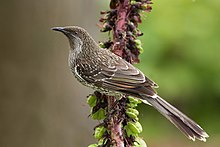Little wattlebird
| Little wattlebird | |
|---|---|

| |
| Scientific classification | |
| Domain: | Eukaryota |
| Kingdom: | Animalia |
| Phylum: | Chordata |
| Class: | Aves |
| Order: | Passeriformes |
| Family: | Meliphagidae |
| Genus: | Anthochaera |
| Species: | A. chrysoptera
|
| Binomial name | |
| Anthochaera chrysoptera (Latham, 1801)
| |
The little wattlebird (Anthochaera chrysoptera), also known as the brush wattlebird, is a passerine bird in the honeyeater family Meliphagidae. It is found in coastal and sub-coastal south-eastern Australia.
Taxonomy
[edit]The little wattlebird was formally described by ornithologist John Latham in 1801 under the binomial name Merops chrysoptera.[2] The species is now placed in the genus Anthochaera that was introduced by Nicholas Aylward Vigors and Thomas Horsfield in 1827.[3][4] The generic name Anthochaera derives from the Ancient Greek anthos 'flower, bloom' and khairō 'enjoy'; the specific epithet chrysoptera derives from Ancient Greek khrysos 'gold' and pteron 'wing'.[5]
The International Ornithologists' Union recognise three subspecies:[4]
- A. c. chrysoptera (Latham, 1801) – eastern and southeastern Australia
- A. c. halmaturina (Mathews, 1912) – Kangaroo Island (South Australia)
- A. c. tasmanica (Mathews, 1912) – Tasmania
The western wattlebird (A. lunulata) was at one time considered as the subspecies A. c. lunulata.[6]

Description
[edit]The little wattlebird is a medium to large honeyeater, but the smallest wattlebird.[7] The appearance is similar to the yellow wattlebird and the red wattlebird.[8] The little wattlebird lacks the wattles, which characterise other members of the genus. Juveniles are duller with less streaking and have a browner eye.[7]
Calls include a strident cookay-cok, a raucous fetch the gun, a mellow guttural yekkop, yekkop and many squeaky, musical lilting notes. The alarm call is a kwock or shnairt!.[8]
Distribution and habitat
[edit]The little wattlebird is found in banksia/eucalypt woodlands, heathlands, tea-tree scrub, sandplain-heaths, lantana thickets, wild tobacco, parks and gardens.[8]
Behaviour
[edit]
Breeding
[edit]Breeding takes place from June to December.[8] The female wattlebird generally constructs the nest,[7] which is a loose, untidy cup of twigs, lined with shredded bark, and placed from 1 to 10 m high in the fork of a banksia, tea-tree or eucalypt sapling.[8] 1-2 eggs are laid and may be spotted red-brown, purplish-red or salmon-pink in colour.[8] The female incubates the eggs alone but both parents care for the young chicks.[7]
Feeding
[edit]Little wattlebirds feed on nectar obtained with a long, brush-tipped tongue, adapted for probing deep into flowers.[7] They also feed on insects, berries, and some seeds.[7] Most feeding is done perched, but some insects are caught in mid-air. Birds may feed alone or in groups.[7]
References
[edit]- ^ BirdLife International (2017). "Anthochaera chrysoptera". IUCN Red List of Threatened Species. 2017: e.T22704460A118664903. doi:10.2305/IUCN.UK.2017-3.RLTS.T22704460A118664903.en. Retrieved 11 November 2021.
- ^ Latham, John (1801). Supplementum indicis ornithologici sive systematis ornithologiae (in Latin). London: Leigh & Sotheby. p. xxxiii.
- ^ Vigors, N.A.; Horsfield, T. (1827). "A description of the Australian birds in the collection of the Linnean Society; with an attempt at arranging them according to their natural affinities (Part 1)". Transactions of the Linnean Society of London. 15 (1): 170–331 [320–321]. doi:10.1111/j.1095-8339.1826.tb00115.x. The title page gives the year as 1826 but the issue was published in 1827.
- ^ a b Gill, Frank; Donsker, David; Rasmussen, Pamela, eds. (2020). "Honeyeaters". IOC World Bird List Version 10.1. International Ornithologists' Union. Retrieved 3 April 2020.
- ^ Jobling, James A. (2010). "Helm Dictionary of Scientific Bird-names". Retrieved 2020-04-24.
- ^ Salomonsen, F. (1967). "Family Meliphagidae, Honeyeaters". In Paynter, R.A. Jnr. (ed.). Check-list of birds of the world (Volume 12). Cambridge, Massachusetts: Museum of Comparative Zoology. p. 446.
- ^ a b c d e f g Birds in Backyards - Little Wattlebird
- ^ a b c d e f Pizzey, Graham; Knight, Frank (1997). Field Guide to the Birds of Australia. Sydney, Australia: HarperCollinsPublishers. p. 111. ISBN 0-207-18013-X.
External links
[edit]- Recordings of little wattlebird from Cornell Laboratory of Ornithology Macaulay Library
- Recordings of little wattlebird from Xen-canto sound archive
- Images of little wattlebird from Graeme Chapman's photo library

